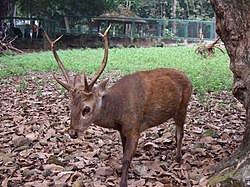| Bawean deer | |
|---|---|
 | |
| Adult male at the Ragunan Zoo, Jakarta | |
| Scientific classification | |
| Kingdom: | Animalia |
| Phylum: | Chordata |
| Class: | Mammalia |
| Order: | Artiodactyla |
| Family: | Cervidae |
| Genus: | Axis |
| Species: | A. kuhlii |
| Binomial name | |
| Axis kuhlii (Temminck, 1836) | |
 | |
| Orange arrow points to Bawean Island. Green on inserted map highlights approximate range of Bawean deer on the island. | |
| Synonyms | |
| |
The Bawean deer (Axis kuhlii), also known as Kuhl's hog deer or Bawean hog deer, is a highly threatened species of deer endemic to the island of Bawean in Indonesia. Due to ongoing habitat loss, small population size and limited range, the Bawean deer is evaluated as critically endangered on the IUCN Red List of Threatened Species. [1] It is listed on Appendix I of CITES. It has few natural enemies except for birds of prey and large snakes such as pythons.
